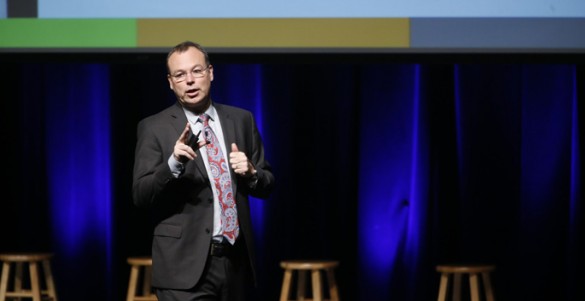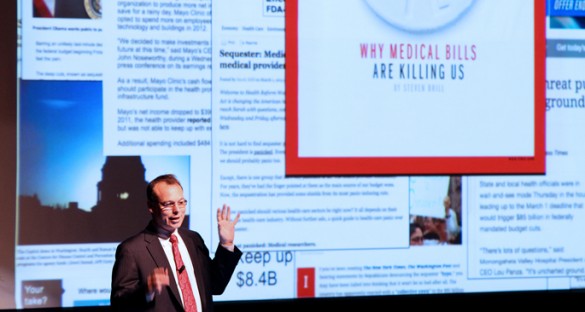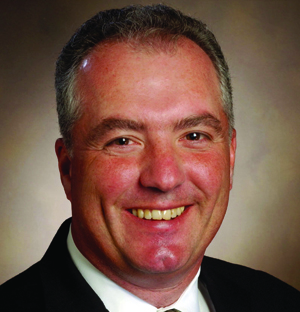
Discovery, education and clinical care will continue to be the core of Vanderbilt University Medical Center’s (VUMC) mission as the date of the legal separation for Vanderbilt University and VUMC nears, Jeff Balser, M.D., Ph.D., vice chancellor for Health Affairs and dean of the School of Medicine, said to a capacity crowd at last week’s Fall Clinical Enterprise Leadership Assembly.
And backed by its tripartite mission, VUMC will also continue to grow the Vanderbilt Health Affiliated Network throughout the Southeast by increasing the number of affiliates and strengthening collaborations to be able to deliver the right care, in the right place, at the right time, Balser said.
“As the national health care economy restructures to fewer health systems, we have a choice — leading such a system or being part of someone else’s system. We want to lead our system and control our destiny. We believe that health care should be delivered in a certain way,” he said.
The theme of last week’s Leadership Assembly was “Transforming VUMC through role modeling,” and included a glimpse of the role models of VUMC’s leaders.
As Balser spoke, an image of a map of the United States representing the life expectancy gap for different parts of the nation appeared on the screen behind him. The map indicates much of the Southeast’s population has a life expectancy that is four years less than the rest of the nation, and even other parts of the developed world. He pointed out that one of few exceptions on the map is the Nashville area where VUMC is based. “How can we look at that and say we’re not going to make a difference in the region?” he asked.
It’s imperative that VUMC be able to offer people throughout the region a way to access its health care in real time, Balser said. “That’s what we’re called to do,” he said, adding that as VUMC partners and works with others, the goal is to reach an additional 1 million lives in the Southeast by 2020.
Balser said VUMC’s model for growth throughout the Southeast is not through the acquisition of other health care systems, but to be a role model organization that fosters collaboration.
An example of this is Monroe Carell Jr. Children’s Hospital’s after-hours clinics in neighboring communities — a model that offers care to the region’s children when the local pediatricians’ offices are closed. “We’re not competing with community pediatricians. We’re their partners,” he said.
Balser also emphasized the importance of offering online appointment scheduling for VUMC clinics and working to reduce the time between a request for an appointment and when the appointment occurs.
C. Wright Pinson, MBA, M.D., deputy vice chancellor for Health Affairs and CEO of the Vanderbilt Health System, provided an update on VUMC’s performance regarding the 2015 Pillar goals and thanked faculty and staff for the progress made in meeting these goals.
He also updated the audience on the health system’s major initiatives: focusing on people; decreasing length of stay; increasing procedures through focused efforts, and improving documentation and coding.
“We can’t accomplish any of our goals without our people. You are the foundation and the most important part of our organization,” he said.
Related to patient capacity demands throughout the Adult Enterprise, Pinson discussed the continuing focus on reducing length of stay as a key to expanding capacity. In addition to an estimated 33 beds gained through an effort to reduce length of stay, 52 new observation beds will be added in phases during 2016. Another 120 beds will be added through construction over the next five years for a total of more than 200 new beds to the Adult Enterprise.
“Also, we have the campaign to expand Children’s. When we add these additional beds, we will have more than 300 additional beds in the next five years,” he said.
“Right now, the key thing we want you to focus on is utilizing the current capacity we have to its maximum benefit. Let’s find creative ways to solve this on a local level as we all work on it at the enterprise level,” he said.
“At a minimum, we need to use the full capacity of our clinic facilities from 8-5. Clinics should be scheduling patients from 8-12 and 1-5 each day,” he said.
Pinson also provided an update on the documentation process for the Medical Center’s annual performance evaluations. The form has been greatly simplified for the coming year for both the mid-year and end-of-year reviews. Now, the evaluation form will rate performance in three domains — Credo, Elements of Performance and Goals; offer two areas to make comments and end with two ‘yes or no’ questions managers can quickly complete.
“This new evaluation process will allow us to spend less time on administrative work, more time on the quality of the discussion and more time focusing on outcome goals each employee is measured on,” he said.
The assembly, which included a performance by the musical group Point of Grace, finished with ‘VUMC Live,’ a panel discussion moderated by Kimberly Pace, M.M., professor of Practice Management with the Owen Graduate School of Management. VUMC leaders participating were Terrell Smith, MSN, Marlee Crankshaw, DNP, Larry Marnett, Ph.D., and Lee Parmley, M.D., J.D.
A video and slides from the Leadership Assembly presentation are available on the Elevate website.















